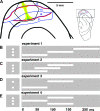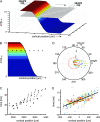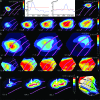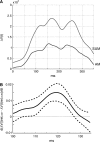Cortical dynamics subserving visual apparent motion
- PMID: 18375528
- PMCID: PMC2583157
- DOI: 10.1093/cercor/bhn038
Cortical dynamics subserving visual apparent motion
Abstract
Motion can be perceived when static images are successively presented with a spatial shift. This type of motion is an illusion and is termed apparent motion (AM). Here we show, with a voltage sensitive dye applied to the visual cortex of the ferret, that presentation of a sequence of stationary, short duration, stimuli which are perceived to produce AM are, initially, mapped in areas 17 and 18 as separate stationary representations. But time locked to the offset of the 1st stimulus, a sequence of signals are elicited. First, an activation traverses cortical areas 19 and 21 in the direction of AM. Simultaneously, a motion dependent feedback signal from these areas activates neurons between areas 19/21 and areas 17/18. Finally, an activation is recorded, traveling always from the representation of the 1st to the representation of the next or succeeding stimuli. This activation elicits spikes from neurons situated between these stimulus representations in areas 17/18. This sequence forms a physiological mechanism of motion computation which could bind populations of neurons in the visual areas to interpret motion out of stationary stimuli.
Figures










Similar articles
-
The role of multi-area interactions for the computation of apparent motion.Neuroimage. 2010 Jul 1;51(3):1018-26. doi: 10.1016/j.neuroimage.2010.03.032. Epub 2010 Mar 18. Neuroimage. 2010. PMID: 20303411
-
Dynamics of population response to changes of motion direction in primary visual cortex.J Neurosci. 2011 Sep 7;31(36):12767-77. doi: 10.1523/JNEUROSCI.4307-10.2011. J Neurosci. 2011. PMID: 21900556 Free PMC article.
-
Suppressive Traveling Waves Shape Representations of Illusory Motion in Primary Visual Cortex of Awake Primate.J Neurosci. 2019 May 29;39(22):4282-4298. doi: 10.1523/JNEUROSCI.2792-18.2019. Epub 2019 Mar 18. J Neurosci. 2019. PMID: 30886010 Free PMC article.
-
Auditory and Visual Motion Processing and Integration in the Primate Cerebral Cortex.Front Neural Circuits. 2018 Oct 26;12:93. doi: 10.3389/fncir.2018.00093. eCollection 2018. Front Neural Circuits. 2018. PMID: 30416431 Free PMC article. Review.
-
Human cortical areas underlying the perception of optic flow: brain imaging studies.Int Rev Neurobiol. 2000;44:269-92. doi: 10.1016/s0074-7742(08)60746-1. Int Rev Neurobiol. 2000. PMID: 10605650 Review.
Cited by
-
Apparent motion perception in patients with paranoid schizophrenia.Eur Arch Psychiatry Clin Neurosci. 2013 Apr;263(3):233-9. doi: 10.1007/s00406-012-0344-5. Epub 2012 Aug 5. Eur Arch Psychiatry Clin Neurosci. 2013. PMID: 22865160
-
Response retention and apparent motion effect in visual cortex models.PLoS One. 2023 Nov 2;18(11):e0293725. doi: 10.1371/journal.pone.0293725. eCollection 2023. PLoS One. 2023. PMID: 37917779 Free PMC article.
-
Contributions of magno- and parvocellular channels to conscious and non-conscious vision.Philos Trans R Soc Lond B Biol Sci. 2014 Mar 17;369(1641):20130213. doi: 10.1098/rstb.2013.0213. Print 2014 May 5. Philos Trans R Soc Lond B Biol Sci. 2014. PMID: 24639584 Free PMC article.
-
Flow detection of propagating waves with temporospatial correlation of activity.J Neurosci Methods. 2011 Sep 15;200(2):207-18. doi: 10.1016/j.jneumeth.2011.05.023. Epub 2011 Jun 2. J Neurosci Methods. 2011. PMID: 21664934 Free PMC article.
-
Decoding information about dynamically occluded objects in visual cortex.Neuroimage. 2017 Feb 1;146:778-788. doi: 10.1016/j.neuroimage.2016.09.024. Epub 2016 Sep 20. Neuroimage. 2017. PMID: 27663987 Free PMC article.
References
-
- Anderson JC, Martin KAC. Connection from cortical area V2 to MT in macaque monkey. J Comp Neurol. 2002;443:56–70. - PubMed
-
- Anstis SM, Mather G. Effects of luminance and contrast on direction of ambiguous apparent motion. Perception. 1985;14:167–179. - PubMed
-
- Bergles DE, Jahr CE. Synaptic activation of glutamate transporters in hippocampal astrocytes. Neuron. 1997;19:1297–1308. - PubMed

